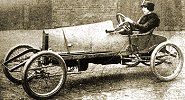 |
Medinger |
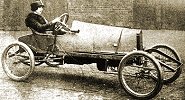 |
|
Emile Medinger, the son of Emil Medinger an Austrian
industrialist, was born in Austria on 21st April, 1884. He built
his first car at the age of 14 and ran it from his parent's
house to the railway station at Gumpoldskirchen, Vienna, where
it broke down. He purchased his first car in 1909 and in the
same year won his first race in the Austrian voiturette
category.
In 1912 he came to Wolverhampton when Sunbeam engaged some of the best continental drivers including
Emile Medinger, Dario Resta, and Victor Rigal. Four Sunbeam 12/16s were entered in the
1912 Coupe de L’Auto, held over a 47 mile circuit at Dieppe. The cars were
basically standard machines with small modifications to the engine and
special tuning. Only cars of up to 3litres could enter the race, which was
run at the same time and on the same course as the French Grand Prix, in
which there were no restrictions on size.
The cars performed extremely well with Rigal finishing in first place,
Resta second, and Medinger third. Due to their astonishing speed they were
also placed in third, fourth, and fifth places in the Grand Prix itself,
beating many much more powerful machines.
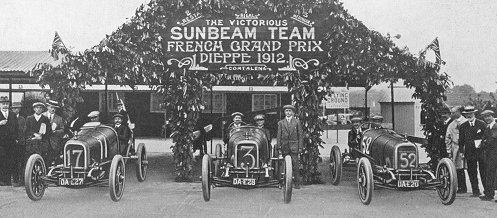
The 1912 team. Left car - Dario Resta and Tommy Harrison, middle car -
Victor
Rigal and Jean Chassagne, right car - Emile Medinger and Isaac Strothers. |
Emile's thoughts turned to building a car of his own design.
In 1912 he founded the Medinger Motor Company with premises in Worcester Street,
Wolverhampton, but the car was probably
built at the Sunbeam car works, possibly in the experimental
department. The Medinger car proved to be
a good performer, with a top speed of around 60m.p.h. |
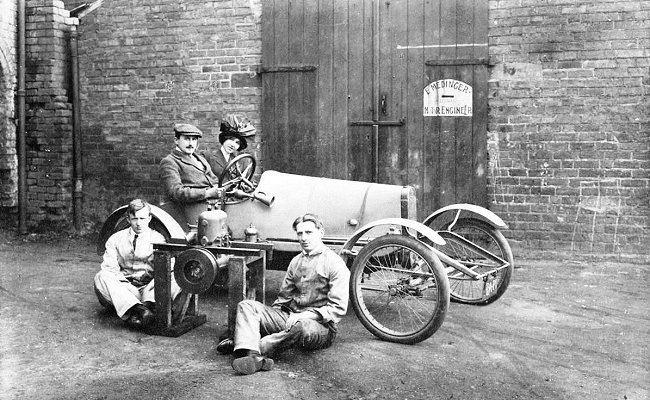
This lovely photograph was kindly sent by
1,005c.c.
two-cylinder, two-stroke. |
|
The following, is a
description of the car that appeared in the Cyclecar magazine, on 16th April
1913. We must thank the late Jim Boulton for locating it.
A Two-Stroke Engine
Developing 16h.p.
The Medinger Cyclecar, Built by the Famous Driver of a Sunbeam Car in the
Grand Prix.
A novelty in cyclecar design is the fitting of a two-stroke
valveless engine, which is the chief feature of a new-comer, the Medinger.
Although at present in a more or less experimental stage, it has given an
excellent account of itself, and, with minor alterations and modifications,
presents practically what will be the finished machine. Chief amongst the
alterations will be a bevel drive in lieu of the existing chain. The
designer and builder is Mr. Emile Medinger, of Worcester Street,
Wolverhampton, who will be recalled as the pilot of one of the successful
Sunbeams in last year's Grand Prix. Naturally, one looks for something of a
speedy nature, emanating as this does from a man of his experience and
capabilities. This assumption is fully justified when we mention that the
car touched 50 m.p.h. on the road when we were aboard.
|
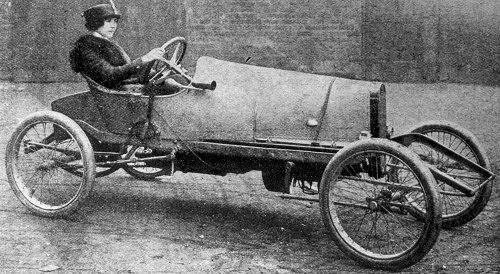 |
The engine, which is a water-cooled two-stroke twin, is
of Mr. Medinger’s own design, and develops 16h.p. at 1800 revolutions.
It has a bore and stroke of 80 mm. by 100 mm. respectively, and is cast
in two halves, the lower half carrying the magneto on an extended table,
while the inlet and exhaust port pipes are bolted on. |
| An elongated radiator terminates a tapering
bonnet. From the engine, transmission is by a leather to metal clutch,
through a gearbox (three speed), which has a bevel drive to a countershaft,
and thence by chain to the back axle, but in future models by cardan shaft
and bevel. The chassis is of channel section, and is supported upon four
semi-elliptic springs. Three pedals are fitted, viz, the accelerator, the
pedal for the clutch, and that for the external contracting brake, which
operates on the rear axle chain sprocket. A countershaft brake is also
provided, the hand level for which operates in a quadrant beside the
change-speed lever. Steering is by a small bevel at the base of the column
to a bevel operating the steering arm. The front axle, is of the straight
tubular type, and a good lock is allowed for. |
| The machine has a long wheelbase and broad track, and
the weight complete works out at about 5cwt. The whole turnout has a
rakish appearance, and there is seating to accommodate two persons.
Mr. Medinger has recently been experimenting with paraffin, and finds his
engine behaves splendidly when it is used, very satisfactory results
having been obtained.
The standard Senspray carburettor fitted
has had no alteration and seems to vaporize the mixture well. A little
priming with petrol is all that is required to start the engine running
satisfactorily. |
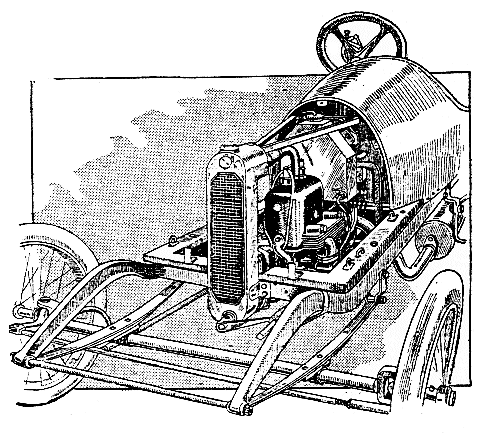
The front view and engine of the Medinger
cyclecar. |
| This is the first cyclecar to be described
fitted with a two-stroke engine, and the performance of this type of motor
will be watched with interest. It will be noted that the frame is of an
unusual shape, this being necessary in order to obtain flat road springs,
which should make the machine hold the road at speed. The lessening of the
head resistance has received careful attention, and the designer's racing
experience has been extremely useful to him. It will be noticed that the
passengers' weight is well over the back axle. |
As well as the 1,005c.c. two-stroke engine, Emile also built a
four-stroke, four cylinder engine. By the summer of 1913 Emile had left
Wolverhampton and moved to a house near Teddington, Middlesex, where he had
an experimental laboratory for his other great interest in life; wireless.
He moved his business to Southall, Middlesex and changed the name to
the Medinger Car & Engine Company. Although
he planned to produce Medinger cars, only the single prototype was ever
built.
At the beginning of the First World War Emile was interned as an enemy
alien. After the war he returned to Austria and took the two engines with
him. In 1930/31 he travelled to China.
Emile's two engines still exist and now belong a relative, Gregor
Medinger. For a time they were on display in the Austrian Motorcycle Museum.
Emile's younger brother Hermann was also interested in vehicles and raced
motorcycles. After a bad spill which ended his racing career, he started to
produce MEZO motorcycles in Austria
I must thank Gregor Medinger for his help in producing
this section about the interesting locally built car, and its designer.
|






